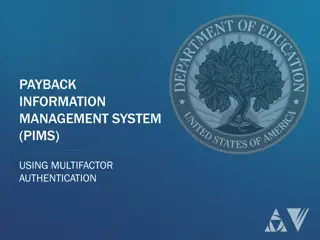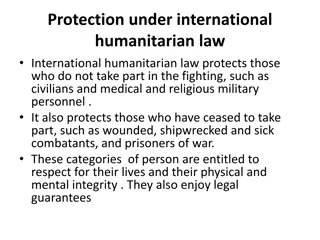Componentisation of Assets: Readiness and Overview for SCOPA June 2023
The readiness of departments and entities within the WCG on the componentisation of assets is discussed along with an overview. Componentisation involves breaking down significant parts of assets into individually identifiable parts with different useful lives. Advantages include accurate tracking o
0 views • 7 slides
Introduction to WISEdata Portal and Data Privacy Guidelines
Explore the WISEdata Portal for new users and learn how to navigate, identify errors, submit help tickets, and become an expert. Understand why DPI collects data, data privacy guidelines, and examples of Personally Identifiable Information (PII). Get started with the WISEdata Portal by accessing WIS
0 views • 32 slides
Understanding Data Use Agreements (DUAs) in Sponsored Projects Office
Data Use Agreements (DUAs) are contractual agreements between data providers and recipients, ensuring proper handling of non-public data, especially data subject to restrictions like HIPAA. DUAs address data use limitations, liability, publication, exchange, storage, and protection protocols. HIPAA
6 views • 19 slides
Essential Information for Starting Your Semester at Tekla Galhead Department of International Affairs
Orientation week at the Department of International Affairs includes practical sessions, campus tours, and essential information for Erasmus, guest, and English Foundation students. The week also features program introductions, Neptun study system insights, and ESN activities to help new students ad
3 views • 23 slides
Understanding VA Privacy Issues and Sensitive Information
Explore the complex landscape of VA privacy issues, including data relationships, sensitive personal information (SPI), personally identifiable information (PII), individually identifiable information (III), and individually identifiable health information (IIHI). Learn about the roles and responsib
0 views • 29 slides
Understanding PeopleSoft Security: User ID Creation and Role Administration
Explore the key aspects of PeopleSoft security including user profile management, role administration, permission lists, and best practices for creating security roles based on business processes. Learn about the importance of security audits, offboarding procedures, and protecting Personally Identi
0 views • 33 slides
Information Security Awareness Training for Personally Identifiable Information at LACCD
This training session by LACCD Office of Information Technology focuses on educating personnel about identifying and handling Personally Identifiable Information (PII) to safeguard student and employee privacy. It covers the definition of PII, laws protecting PII, responsibilities in protecting PII,
0 views • 26 slides
Understanding PeopleSoft Security: A Comprehensive Guide
Explore the intricacies of PeopleSoft security, including user profiles, roles, permission lists, and the importance of business process-based role design. Discover how security safeguards Personally Identifiable Information (PII) data, the significance of ZC/ZZ/ZD roles, and the role of SACR securi
4 views • 41 slides
Cost Allocation, Apportionment, and Absorption in Accounting
Cost allocation involves charging identifiable costs to specific cost centers or units, while cost apportionment distributes costs that cannot be directly identified among various departments. This process is crucial for managing overheads effectively in accounting practices. Dr. B. N. Shinde discus
1 views • 16 slides
Importance of Confidentiality in Shelter Monitoring Committee Training
Exploring the significance of confidentiality in the work of a shelter monitoring committee, this educational material delves into definitions of privacy, confidentiality, and personally identifiable information (PII). It emphasizes the critical role of confidentiality in building trust with the unh
0 views • 18 slides
Understanding Privacy in Information Security Training
Privacy awareness training is crucial, covering topics such as the definition of privacy, importance of privacy protection, Personally Identifiable Information (PII), and Sensitive PII. Discover why privacy is vital to maintaining public trust, preventing identity theft, and complying with laws. Lea
0 views • 55 slides
Klebsiella Species: Characteristics and Pathogenicity
Klebsiella species, such as K. pneumoniae and K. oxytoca, are gram-negative bacilli commonly found in the microbiota of the intestines, nasopharynx, and feces. They exhibit distinct characteristics like pink mucoid colonies on MacConkey's agar and are known to cause both community-acquired and hospi
0 views • 24 slides
Understanding FERPA: Family Educational Rights and Privacy Act
FERPA, the Family Educational Rights and Privacy Act, is a federal law that safeguards the confidentiality of student educational records and privacy rights. It grants parents rights until the student turns 18 or enters a postsecondary institution. Students can inspect records, seek amendments, cons
0 views • 19 slides
UW School of Nursing BSN Program Information Session Highlights
Discover the details of the UW School of Nursing BSN program through an information session covering admissions, prerequisites, and application process. Learn about the state-of-the-art facilities, nationally acclaimed faculty, and community partnerships. Gain insights into the rigorous academic req
0 views • 19 slides
British Academy Small Grants Scheme 2020
The British Academy Small Grants Scheme provides funding for primary research in humanities and social sciences. It supports collaborative or individual research projects, and international collaborations with a UK-based lead applicant. The funds facilitate project planning, research costs, and work
1 views • 15 slides
FMCSA Privacy Awareness Training Overview for 2022
Understanding the importance of privacy and Personally Identifiable Information (PII) in the context of the Federal Motor Carrier Safety Administration (FMCSA). The training covers topics such as the definition of privacy, why privacy is crucial, what constitutes PII, the significance of sensitive P
0 views • 55 slides
Understanding HIPAA and FERPA Privacy Laws in Schools
Collaboration between community and school health care providers involves adherence to federal privacy laws such as FERPA and HIPAA. FERPA protects educational records and personally identifiable information (PII), requiring written consent for disclosure. HIPAA safeguards protected health informati
1 views • 14 slides
Safeguarding Personal Information at DHS
Learn about the importance of protecting personal information at the Department of Homeland Security (DHS) to prevent identity theft and privacy incidents. Understand the obligations, risks, and methods for safeguarding Personally Identifiable Information (PII), as well as reporting privacy incident
0 views • 31 slides
Student Data Transparency and Security Act Overview
The Student Data Transparency and Security Act (HB 16-1423) aims to increase transparency and security of student personally identifiable information (PII). The act involves collaboration between sponsors, parents, vendors, and education entities to protect student data. Key components include defin
2 views • 17 slides
Proposed Conservation District Ordinance Benefits and Criteria
Proposed Conservation District Ordinance Super Neighborhood Alliance meeting discusses benefits of conservation districts in preserving area character, supporting development, and ease of establishment. Criteria for creating districts are outlined by the Houston Archaeological and Historical Commiss
0 views • 8 slides
Enhancing Security with Multifactor Authentication for PIMS
Multifactor Authentication (MFA) is crucial for the Payback Information Management System (PIMS) as it significantly reduces the risk of unauthorized access, safeguarding personally identifiable information and preventing system-wide data breaches. Learn how to enroll in MFA for PIMS, the steps invo
0 views • 20 slides
Understanding Alabama Data Breach Notification Act for County Governments
Alabama's Data Breach Notification Act requires all county governments and related entities to comply with specific security measures to protect sensitive information of residents. The law mandates prompt investigation and notification in case of a breach, defining what constitutes a breach and sens
1 views • 36 slides
Cyber Security and Data Privacy Recommendations in Autonomous Vehicles
The recommendations provided by the Subcommittee on Cyber Security and Data Privacy Advisory Council address key considerations such as definitions, data classification, security protocols, public-private partnerships, regulatory frameworks, and data collection, storage, and distribution in the cont
0 views • 26 slides
Understanding Crystalarthropathies and Gout: A Comprehensive Overview
Crystalarthropathies encompass a group of diseases characterized by hyperuricemia and uric acid crystal formation, leading to conditions like gouty arthritis and nephrolithiasis. Primary gout, characterized by hyperuricemia without an identifiable underlying cause, primarily affects older men. Mecha
0 views • 34 slides
British Academy Small Grants Scheme Overview
The British Academy Small Grants Scheme provides funding for primary research in humanities and social sciences, supporting both individual and collaborative projects with a focus on clear research objectives and identifiable outcomes. Funded by the British Academy and the Leverhulme Trust, the sche
0 views • 15 slides
Proposed Rulemaking on Biospecimen Research: Federal Policy Update
The proposed rulemaking aims to enhance the protection of human subjects in research involving biospecimens. Key changes include expanding the definition of human subjects, requiring informed consent for biospecimen research, allowing broad consent for secondary research, and creating exemptions to
0 views • 17 slides
Privacy and Security Basics for Evidence-Based Program Data Collection
Explore the essentials of the Privacy Act of 1974 and the training needed to safeguard Personally Identifiable Information (PII) in evidence-based programs. Understand who requires privacy training, the types of information protected, roles and responsibilities, and the importance of data security m
0 views • 21 slides
IEEE 802.11-21/1585r10: Identifiable Random MAC Address Presentation Summary
This presentation discusses the concept of Identifiable Random MAC (IRM) addresses in the IEEE 802.11-21/1585r10 standard. It covers the purpose of IRM addresses in preventing third-party tracking while allowing trusted parties to identify specific devices. The presentation outlines the use of Ident
0 views • 24 slides
Understanding Family Educational Rights and Privacy Act (FERPA) in Public Schools
FERPA is a federal law that grants parents and adult students the right to access educational records while also setting guidelines for data release to ensure student privacy. Key terms and exceptions regarding educational records are explained, along with what constitutes personally identifiable in
0 views • 28 slides
Understanding Liability of Individuals in Maine Business Entities
Maine business entities, including corporations and LLCs, offer limited liability protections for owners and managers. Shareholders of corporations are not personally liable for the entity's debts, except in specific circumstances. Similarly, members and managers of LLCs are not personally obligated
0 views • 32 slides
Implementing Multifactor Authentication for Enhanced Security in Professional Development Program Data Collection System
Multifactor Authentication (MFA) is a crucial security process that enhances the protection of personally identifiable information (PII) and reduces the risk of unauthorized access and data breaches in the Professional Development Program Data Collection System (PDPDCS). This article provides insigh
0 views • 20 slides
Funding After a NO Vote: Reform of Barnett & Implementation of Scotland Act 2012
Presentation by David Heald at the Scottish Constitutional Futures Forum discussing the financial implications of the NO vote on funding, the challenges with the Barnett formula, and the impact on devolution financing in the UK. The presentation explores identifiable expenditure variances across reg
0 views • 12 slides
Understanding Robot Localization Using Kalman Filters
Robot localization in a hallway is achieved through Kalman-like filters that use sensor data to estimate the robot's position based on a map of the environment. This process involves incorporating measurements, updating state estimates, and relying on Gaussian assumptions for accuracy. The robot's u
0 views • 26 slides
Integrated Vocational Preparation Task for Practical Application and Assessment
This vocational preparation task focuses on practical application of knowledge and skills through a substantial piece of work. Students undertake individual or group tasks with identifiable contributions. The assessment requires evidence of task completion through reports and presentations. The ente
0 views • 30 slides
Regulation of Non-Personal Data and Its Scope
The discussion delves into the expanding scope of legal instruments surrounding personal data regulation, including the definitions and implications of identifiable natural persons, processing of personal data, and metadata. It explores the necessity of regulating non-personal data alongside persona
0 views • 9 slides
Understanding Data Awareness and Legal Considerations
This module delves into various types of data, the sensitivity of different data types, data access, legal aspects, and data classification. Explore aggregate data, microdata, methods of data collection, identifiable, pseudonymised, and anonymised data. Learn to differentiate between individual heal
0 views • 13 slides
Unilateral Sudden Sensorineural Hearing Loss After General Anesthesia: A Case Report
A 36-year-old female experienced a sudden sensorineural hearing loss of 30 dB or more in at least three consequent audiometric frequencies following general anesthesia for lipoma excision. This case highlights the importance of thorough diagnosis, including ruling out potential ototoxic drugs and un
0 views • 22 slides
International Humanitarian Law: Protection and Regulations
International humanitarian law safeguards civilians, medical personnel, and combatants who are wounded, sick, or imprisoned during armed conflicts. It prohibits indiscriminate warfare methods, ensures humane treatment for all parties, and mandates the use of identifiable symbols for protection. Nati
0 views • 9 slides
Protecting Password Identifiers in IEEE 802.11-21
This submission addresses the need for safeguarding password identifiers in SAE to ensure privacy and prevent attackers from constructing personally identifiable information. The document presents two potential solutions, ultimately recommending the use of symmetric cryptography for efficient protec
0 views • 11 slides
Combining Technicals with Fundamentals for Successful Trading Patterns
Technical analysis involves recording trading history in graphical form to predict future trends. Identifiable patterns like Cup and Handle play a crucial role in spotting entry and exit points in the market. By combining technical analysis with fundamental factors such as company performance and se
0 views • 37 slides







































